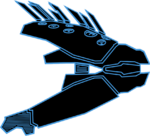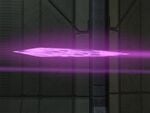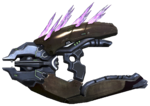Type-33 needler: Difference between revisions
From Halopedia, the Halo wiki
(→Trivia) |
|||
| Line 50: | Line 50: | ||
==Design Details== | ==Design Details== | ||
[[File:Needler.png|thumb|left|150px|A blueprint of the Needler in the ''Halo Trilogy''.]] | [[File:Needler.png|thumb|left|150px|A blueprint of the Needler in the ''Halo Trilogy''.]] | ||
[[File:ReachSchematic - Needler.png|150px|thumb|left|A blueprint of the Needler in ''Halo: Reach''.]] The | [[File:ReachSchematic - Needler.png|150px|thumb|left|A blueprint of the Needler in ''Halo: Reach''.]] The Needler is a Covenant projectile weapon that fires long, sharp crystalline shards that are guided until they impale a target — hence the “needler” moniker. Several seconds after coming to rest in their target, the needles detonate, creating severe and in most cases fatal wounds. The needler's top plate has 14 holes, with the needles protruding out of the holes. When the trigger is pulled, the needle is fed from the top into the "barrel" of the weapon, and fired at high speed. The Type-33 GML is used by Covenant foot soldiers of nearly all types. [[Yanme'e]] are also fond of this weapon, and their efficiency with it is high as their flying capabilities and large numbers make the needles harder to dodge. When the trigger is held down, the rate at which the 'needles' are fired increases. | ||
The needler is one of the most unusual weapons in the Covenant arsenal and the least understood; how the weapon functions and how the shards are able to track their targets remains a mystery to human military experts and scientists. | The needler is one of the most unusual weapons in the Covenant arsenal and the least understood; how the weapon functions and how the shards are able to track their targets remains a mystery to human military experts and scientists. | ||
Revision as of 14:59, September 21, 2010
Template:Weapon Template:Article Quote
The Type-33 Guided Munitions Launcher[1][2], more commonly known as the Needler, is a Covenant infantry weapon.
Design Details
The Needler is a Covenant projectile weapon that fires long, sharp crystalline shards that are guided until they impale a target — hence the “needler” moniker. Several seconds after coming to rest in their target, the needles detonate, creating severe and in most cases fatal wounds. The needler's top plate has 14 holes, with the needles protruding out of the holes. When the trigger is pulled, the needle is fed from the top into the "barrel" of the weapon, and fired at high speed. The Type-33 GML is used by Covenant foot soldiers of nearly all types. Yanme'e are also fond of this weapon, and their efficiency with it is high as their flying capabilities and large numbers make the needles harder to dodge. When the trigger is held down, the rate at which the 'needles' are fired increases.
The needler is one of the most unusual weapons in the Covenant arsenal and the least understood; how the weapon functions and how the shards are able to track their targets remains a mystery to human military experts and scientists.
Ammunition
Razor-sharp crystalline projectiles are fired from this elaborately designed Covenant weapon; it is widely believed that these needles use heat or organic signatures to home in on targets, and may have some relation to the Plasma Grenade and the Plasma Pistol's charged shots, which also react to living tissue and Sentinel mechanics. The needles appear to have some sort of "identify-friend/foe" function, as they will home in on hostile targets but not allies of the wielder. Once fired, a needle will seek its target until impact, entering the victim's body violently. After several seconds, the contents of the crystalline shard will detonate; injuries inflicted from the exploding shard are gruesome, as microscopic pieces of shrapnel can become embedded in tissue.
Needlers cause two types of damage: penetration, getting hurt on impact of the crystalline needles, and explosive, explosion of needles wedged in the body and splash damage to surrounding units. A crystalline projectile can cause fatal damage to its victim—a single shard can cause internal bleeding or strike a vital organ, with untreated wounds resulting in death. Depending on the impact area and angle, several crystalline shards can cause amputation of limbs, and impacts to the chest are in most cases fatal; the explosive properties can easily crack ribs, damage the lungs or heart, and cause severe flesh damage that can be very difficult to repair.
The crystalline projectile appears to contain some type of gas or energy, which is released upon impact with a target; after seven or more needles have struck a target in the same general area, the needles will react to each other, triggering an explosion that kills the victim instantly. When either a single or multiple needles detonate, they release crystal shrapnel, which can embed itself in nearby organisms; thus, friendly fire is often a necessary consideration in close quarters combat.
Advantages
The Type-33, unlike other Covenant weapons, allows the user to aim at the closest target, fire and move on, as its homing ability allows its user to avoid being exposed to enemy fire while inflicting his own. The more needle shards that impact the target, the higher degree of damage it will do to the target, seven or more needle shards detonating at the same place will cause a massive explosion that will cause splash damage and cause shrapnel damage, which can also cause nearby explosives to detonate, giving the enemy another reason to run. The projectiles ricochet when they hit rigid surfaces at oblique angles and retain sufficient velocity, making dodging them a challenging feat.
Disadvantages
While the Type-33 GML is incredibly effective against most infantry, it is much less effective against vehicles. The crystalline projectiles are slow and ineffective to even light armor and will simply bounce off of them. The Needler is also limited to medium range combat situations and even at that range is not as effective, as the projectile travels it loses velocity and thus loses altitude, reducing the chances of impacting a target. In order for the tracking ability to be most effective the targeting reticule on the users heads up display must acquire the target, or if no targeting reticule is available the user must judge how close he must be to a target in order to effectively use the weapon. While the homing ability is incredibly useful the crystalline shard cannot track a target relentlessly, turning at a certain angle will cause the projectile to simply keep flying and miss the target completely, fast turns at certain angles will also cause the projectile to lose the target and travel onward. The needler is also ineffective against linear energy fields, like the Point Defense Gauntlets carried by the Kig-Yar, or stationary energy shields; as the projectiles are repelled without detonating. Another, more minor disadvantage, is that the Needler is unsuited to setting off explosive devices like Fusion Coils, often requiring several clips of ammunition to destroy one.
Changes
The Needler makes its first appearance in Halo: Combat Evolved, and while its effectiveness was limited to close range, the Needler was still dangerous if the player managed to get seven needles to hit an enemy target. The Needler in the first game is larger than its Halo 2 and Halo 3 counterparts, and its maximum ammo is only 80 needles. The needles' super-combine explosion could also cause nearby grenades to go off, and either do damage or kill nearby friendlies or enemy infantry. When viewed in first person, the needle shards that protrude from the weapon have a blue tinge to them until fired, then take on the pink coloring.
Changes from Halo: Combat Evolved to Halo 2
- The Needler is now smaller, and is one of the dual-wieldable weapons.
- The Needler's projectiles when viewed in first person now have a pink tinge to them instead of blue.
- The magazine size has increased to thirty needles. Maximum ammunition increased from 80 needles to 90 and its maximum amount of magazines decreases by one.
- Explosion has significantly less splash damage.
- Only one explosion will go off within an enemy, while in Halo: Combat Evolved multiple explosions could go off in one body, even after death.
- Slower rate of fire.
- Melee animation is different, and attacks are faster than in Halo: Combat Evolved. However, they do less damage, due to the firing muzzle hitting the target, instead of the needles impaling the enemy.
- The explosion of the Needler is stronger, about as strong as a plasma grenade.
- No more ammunition in magazine form on the ground.
Changes from Halo 2 to Halo 3
- The Needler can no longer be dual-wielded since the weapon now does more damage alone than it did when dual-wielded.
- The Needler's reticule should be red in order for the needles to home in on an enemy.
- Magazine size has been decreased to 19 rounds.
- Elites will never wield Needlers in-game unless actually given one by the player.
- Rate of fire has been dramatically increased. The projectiles themselves also travel a lot faster, however their altitude decreases over time.
- The reload time has been decreased.
- Unexploded needles remain impaled to the victim after impact. The needles explode after a short period.
- The reticule is now a bit smaller.
Halo Wars
- The Needler's projectiles neither track nor explode.
Changes from Halo 3 to Halo 3: ODST
- More needles are required to cause a target to explode.
- Jackals and Brutes can now use Needlers by default.
Changes from Halo 3 and Halo 3: ODST to Halo: Reach
- The stock of the Needler has been significantly extended in context to the past three Halo games.
- Needles will no longer track your target if your reticule isn’t red, and just like the Needle Rifle’s projectiles, you won’t be rewarded with a super-combine until after your opponent’s shields have dropped.[3]
- The Needler now has a new reticule system that now shows you an indicator when it will lock on and track your target, similar to the Rocket Launcher from Halo 2 and the Missile Pod from Halo 3.
- The Needler's magazine size has been increased to 24 rounds.
- The weapon now takes 6 needles to take down a Spartan-III's shields, 7 for an Elite's shields and 6 more needles to supercombine.
- The Needler in Halo: Reach now looks more like the Needler from Halo: Combat Evolved, including the shape and color scheme.
- The projectiles seem sharper and more solid.
Tactics
The Needler is best used at close to medium range against groups of enemies in the open. The wielder should be familiar with the amount of lead necessary to make the shots connect, and have a fundamental understanding of the weapons strengths and weaknesses.
Campaign
- In Halo: Combat Evolved, the Needler proves effective against large quantities of Flood Infection Forms when there's no MA5B available, as each form does only require one round to be killed.
- It is not advisable to engage enemies whom are equipped with Active Camouflage with a Needler, as the needle shards will not track them. A good tactic is to switch to an automatic weapon and fire it at them, as soon as they become visible switch back to the Needler and lay into them.
- In Halo 2, Needlers should be dual-wielded if possible, or it will be nearly impossible to lodge seven needles in an enemy before some of them detonate.
- Target the enemy group leader unless the leader is an Sangheili Ultra, Jiralhanae Chieftain, or Jiralhanae War Chieftain, in which case you should fall back and switch tactics and weapons for the situation. The three aforementioned special units' shielding will disable the needles' impact.
- When you are in a tight spot with a lot of enemies near by on higher difficulties, it's best to hide behind something and pick them off with tracking weapons like the needler. Just stick your head out and target an Elite, or Brute, fire off a clip of needles, and repeat.
Multiplayer
- If you are facing an opponent who's wielding a needler, stay at a distance. If this is not possible, run sideways at 90 degree angles from the direction your opponent is. This way the needles have more time to travel and it's easier for you to run away and avoid them. If you're far enough away, the projectiles may not even reach you. it's easy to take out a needler wielding enemy with a headshot capable weapon.
- Enemies with a Needler can't harm you when you're in a vehicle, except if they are shooting your visible part.
- The best place to use Needlers are where they can't escape or are not paying attention to you.
- Never train the Needler on a single target for too long. Rather, with the technique of fire, acquire, repeat you can end up demolishing enemy ranks as the needles do their own job of finding targets.
- It is not widely used due to the bright and easily recognizable rounds.
- Do not head into an open area with no cover and blast away at your enemies. The projectiles may only strike one enemy if you don't switch targets, and since the needles take a few seconds to explode, you could be killed before any helpful explosion occurs.
UNSC Remarks
- "I don’t know how it works, but it seems the needles can only follow you if they can "see" you."
- "Anything stuck with enough needles will blow sky high—and if a Foxtrot is unlucky enough to be carrying grenades, those are gonna cook off too."
- “I caught three in the leg as I was diving behind a broken wall—they lodged right in there where the greave meets the boot. When they went off it damn near broke my ankle and flung like little splinters of glass or crystal or whatever all up my left side—the corpsman was pulling the shards outta me for the better part of two hours.”
- “Luckily—listen to me 'luckily'—the needles only detonate when they’re embedded in living tissue. Now that’s lucky because it’s not gonna blow a hole in the wall you’re hiding behind or tear the tires off of the vehicle you’re trying to escape in.”
- “It’s about as close to a fire-and-forget small arm that we're likely to ever see—and it ain’t ours. This is why we’re losing.”
- “First order of business when dealing with a hostile armed with a Needler is finding cover; second order of business is killing the Mike Foxtrot with the Needler.”
Trivia
- Instead of each needle on top of the Needler pushed separately into the gun with each shot as would be expected, like a visible magazine, all 14 needles sink into the weapon slightly for each shot fired.
- In Halo: Combat Evolved, the Needler is much larger and heavier than in other Halo games, but most weapons appeared so in Halo: Combat Evolved, since dual wielding hadn't been implemented.
- On the Halo 2 level Sacred Icon, near the first Enforcer fight, behind the Anti-Gravity Gondola, there are three overloaded Needlers with 135 needles each.
- There is a lone Sentinel that fires Needler rounds and drops a Needler when it is destroyed. It is found on the level Quarantine Zone in Halo 2.
- In Halo 3, if you look at your shadow while holding a Needler, you'll find that regardless of how many needles are protruding from the top, there will not be any needles visible in the shadow.
- The Halo 3 Needler is incorrectly labeled as having 30 needles per magazine, instead of the actual 19.
- In Halo 3, killing five enemies with a Needler, in a ranked free-for-all match or Campaign will reward the player with the Fear the Pink Mist achievement. In Halo 3: ODST, killing 10 Covenant soldiers with an explosion from the needler in a single player level or in Firefight will reward the player with the Pink and Deadly achievement.
- In Halo: Ghosts of Onyx, the Needler is referred to as a pistol. This may be because in the large hands of a Sangheili, it appears to have a smaller shape.
- The Needler is Fleet Master Voro Nar 'Mantakree's next-to trademark weapon, the other being the Energy Sword.
- The Heavy Needlers were customized to be able to strike aircraft and vehicles, not just living tissue, as proven by their anti-air capabilities.[4]
- In other media, Needlers are depicted as significantly more powerful than their in-game counterparts, with one needle sufficient for causing debilitating pain and a state of near shock.
- In Halo: Combat Evolved, the level 343 Guilty Spark, and the Halo 2 Vista map Uplift are the only level in any of the Halo games to have Needler ammunition outside of the Needler.
- The ammunition for the Needler was referred as "Blamite" by Bungie.[5] The name blamite comes from Bungie's rather unique method of censoring swearing on their forums. The objectionable word is replaced by -blam!-.
- A rifle counterpart of the Needler, the Needle Rifle, is introduced in Halo: Reach.
- When you melee with the Needler, a quiet beeping noise can be heard.
Gallery
- Needler Halo 3.jpg
The Halo 3-era Needler.
A first person view of the Needler during the Halo: Reach Beta.






